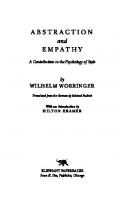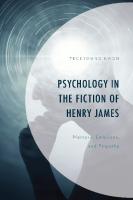Abstraction and Empathy: A Contribution to the Psychology of Style 9781566631778
Worringers classic study argues that in historical periods of anxiety and uncertainty, man seeks to abstract objects fro
289 66 9MB
English Pages 168 [161] Year 1997
Recommend Papers

- Author / Uploaded
- Wilhelm Worringer
File loading please wait...
Citation preview
ABSTRACTION and EMPATHY A
Contribution to the Psychology of Style
by WILHELM WORRINGER Translated from the German
by Michael Bullock
With an Introduction by HILTON KRAMER
ELEPHANT PAPERBACKS Ivan R. Dee, Publisher, Chicago
ABSTRACDON AND EMPATIIY. The special contents of this edition copy right© 1997 by Ivan R. Dee, Inc. Introduction copyright© 1997 by Hilton Kramer. All rights reserved, including the right to reproduce this book or por tions thereof in any form. For information, address the publisher at 1332 North Halsted Street, Chicago 60622.
und Einfuhlung. It was first published in English in the United States of America in
This book was first published in 1908 in Germany as Abstraktion
1953 and is here reprin ted by arrangement with International Universities Press. First ELEPHANT PAPERBACK edition published 1997 by Ivan R. Dee, Inc. Manufactured in the United States of America and printed on acid-free paper. Library of Congress Cataloging-in-Publication Data: Worringer, Wilhelm, 1881-1965
[Abstraktion und Einfiihlung. English] Abstraction and empathy : a contribution to the psychology of style
I by
Wilhelm Worringer ; translated by Michael Bullock ; with an introduction by Hilton Kramer. - ht Ele phan t pbk. ed. p. cm. Originally published: New York : International Univ er si ties Press, 1953. With new introd.
Includes index. ISBN 1-56663-177-7 1. Art, Abstract. 2. Art-Psychology. I. Title. N7432.5A2W6713 1997 709'.04'052�k21
97-14826
CONTENTS
Introduction by Hilton Kramer Foreword to the New Impression, 1948 Foreword to the First Edition Foreword to the Third Edition
vii xv
xxi xxii
I. TH E OR ETICAL S ECTI ON
1. Abstraction and Empathy 2. Naturalism and Style
3 26
II. PRACTICAL S ECTI ON
3. Ornament 4. Selected Examples from Architecture and
51
Sculpture from the Viewpoints of Abstraction and Empathy 5. Northern Pre-Renaissance Art
78 106
Appendix: Transcendence and Immanence in Art Notes Index
122 136 141
I N TRODU C T IO N by Hilton Kramer
FEW
DOCTORAL DISSERTATIONS have come to occupy as important a place in the history of modernist art and crit icism as Wilhelm Worringer's Abstraction and Empathy. The young German scholar, born the same year as Pablo Picasso, completed the dissertation in 1906 at the age of twenty-five. This was one year before Picasso created Les Desmoiselles d'Avignon, a work with which Abstraction and Empathy shares certain interests-particularly the interest in primitive, non-Western art forms. When the disserta tion was published that year in a private edition, as acade mic custom required, the book excited sufficient intellec tual interest in Germany for the Munich publisher Reinhard Piper to bring out a trade edition in 1908. By 1910 that edition had gone into a third printing, and by then the author's ideas about abstraction in art were the subject of intense discussion in the Munich-based Blaue Reiter circle of Franz Marc and Vasily Kandinsky. It was not only in Germany, however, that the book found interested readers. In January 1914, by which time abstract painting was a flourishing feature of the European avant-garde, a young English poet, critic, and philosopher by the name of T. E. Hulme was introducing Worringer's ideas to a London audience with a lecture on "Modern Art and Its Philosophy." Hulme, who was to exert a significant vii
INTRODUCTION
influence on the early critical thought of T. S. Eliot, had met the author of Abstraction and Empathy at a conference in Berlin. He was the first English critic to recognize the book's importance. Abstraction and Empathy remained untranslated into English until 1953, yet by that time its ideas had already been introduced to American literary criticism in a bril liant essay called "Spatial Form in Modern Literature" by the twenty-seven-year-old Joseph Frank, who was later to achieve even greater renown for his multivolume biogra phy of Dostoevsky. Published by Allen Tate in three con secutive issues of the Sewanee &view in 1945, "Spatial Form in Modern Literature" was itself instantly recognized as a classic of modern criticism. It was in that essay that I first heard of Abstraction and Empathy when I was an under graduate in the late 1940s. It remains for me today one of the key documents in the literature of modernism. It needs to be understood, however, that Worringer himself was not writing about modernist art in Abstraction and E mpathy. He was writing about the art of the European past, but in a way that proved to be modernist in its assumptions. For it specifically called into question what, in the Foreword to the third edition of Abstraction and Empathy, Worringer described as "the one-sidedness and European-C lassical prejudice of our customary historical conception and valuation of art." This inquiry led him to ponder the spiritual implications of the stylistic differ ences that distinguished certain periods of Western art from each other as well as the even more dramatic stylistic differences that were seen to separate primitive art-the tribal art of primitive peoples-from, say, the tradition of C lassical antiquity and the Renaissance in Europe. In pursuit of this inquiry into what Worringer called "the psychology of style," his studies took him to the great collection of ethnographical art at the Trocadero museum viii
INTRODUCTION
(now the Musee de l'Homme) in Paris. This would have been some time before 1906, by which time the influence of African tribal sculpture on the art of the Fauves in France and the Briicke group in Germany was well known to the artistic intelligentsia of both countries. It is there fore hard to believe that Worringer remained unac quainted with these developments-or, indeed, with the use that Gaugin made of the primitive art of the Pacific islands in his work even earlier-during the writing of Abstraction and Empathy. Yet nowhere in the book does its author mention them. (It may be, of course, that it was thought to be detrimental to his academic career for a young scholar to be seen to be acquainted with such unseemly developments.) Be all that as it may, it was clear ly in the primitive art he studied in the then rarely visited Trocadero collection that Worringer's ideas for Abstraction and Empathy were confirmed-the same collection, it is worth noting, in which Picasso later claimed to have expe rienced the revelation that led to the completion of Les Desmoiselles d �vig;non.
Whether or not Worringer was writing out of an unac knowledged awareness of contemporary developments, or, as he claimed, in complete ignorance of the avant garde of his time, what remains central to Abstraction and Empathy is the essential distinction it makes between art that takes pleasure in creating some recognizable simu lacrum of three-dimensional space-the "real" space of our waking experience-and art that suppresses that spa tial illusion in favor of something flatter, more constricted and abstract. Worringer understood-as so many acade micians of his time did not-that each of these approach es to art was capable of producing a certain kind of beau ty, yet that each stood in a very different existential rela tion to the world of experience. Whereas the one not only accepted but greatly idealized that world, the other was ix
INTRODUCTION
made anxious and uncertain by it and thus felt compelled to devise artistic strategies designed to minimize its sover eignty. It was the latter that Worringer dubbed the will to abstraction. What proved to be so timely in Abstraction and Empathy was Worringer's further claim that this will to abstraction was to be understood to be one of the two fundamental aesthetic impulses known to human culture-the other, of course, being the urge to empathy which manifests itself in the naturalistic depiction of the observable world. Basing his studies on diverse cultures, styles, and periods, Worringer found "the need for empathy and the need for abstraction to be the two poles of human artistic experi ence.... They are antitheses which, in principle, are mutu ally exclusive. In actual fact, however, the history of art represen ts an unceasing disputation between the two ten dencies." From this perspective, abstraction was elevated to the plane of a universal principle as well as a spiritual impera tive. For its real source was said to reside in something deeper than art itself-in what Worringer called "a psychic attitude toward the cosmos." Whereas the precondition for the urge to empathy is a happy pantheistic relationship of confidence between man and the phenomena of the external world, the urge
to
abstraction is the outcome of a greater inner unrest
inspired in man by the phenomena of the outside world;
in a
religious respect it corresponds to a strongly tran
scendental tinge in all notions. We might describe this state as an i mmense spiritual dread of space.
According to Worringer, then, the aim of abstraction was "to wrest the object of the external world out of its natur al context, out of the une ndin g flux of being, to purify it of all its dependence upon life, i.e., of everything about it x
INTRODUCTION that was arbitrary, to render it necessary and irrefragible, to approximate it to its absolute value." He went even further, moreover, in specifying that this impulse to abstraction entailed the "strict suppression of the representation of space." "Space," insisted Worringer, "is...the major enemy of all striving after abstraction, and hence the first thing to be suppressed in the representa tion. This postulate is interlocked with the further postu late of avoiding the third dimension, the dimension of depth, in the representation, because this is the authentic dimension of space." It was this aspect of his theory, which found in the will to abstraction an expression of man's instinctive feeling of alienation and dread in regard to the hostile world he inhabits, that Wortinger derived from his study of the trib al art of primitive peoples. The style most perfect in its regularity, the style of the high est abstraction, mo st strict in its exclusion of life, is pecu liar to the peoples at their most prim itive cultural level
.
A
ca usal connection must therefore exist between primi tive
culture and the highest, purest regular art-form. And the further proposition may be stated : The less mankind has
succeeded, by virtue of its spiritual cognition in entering into a relation of friendly confidence with the appearance of the outer world, the more forceful is the dynamic that leads to the striving after this highest abstract beauty. ,
Wortinger also understood that this feeling of alienation e xpressed in the will to abstraction was a phenomenon of immense relevance to modern culture. "That which was previously instinct is now the ultimate product of cogni tion," he wrote. And taking his cue from Schopenhauer, he cautioned his readers to understand that "man is now just as lost and helpless vis..








